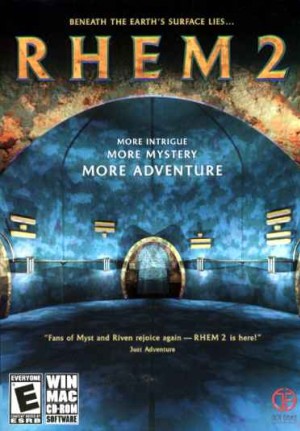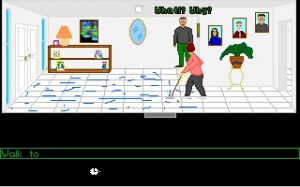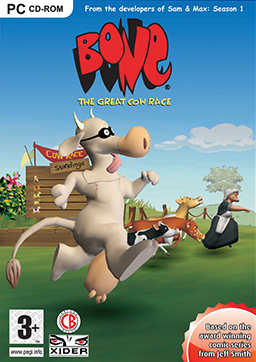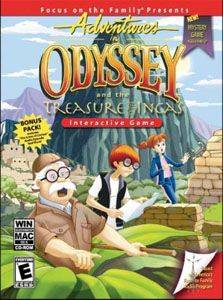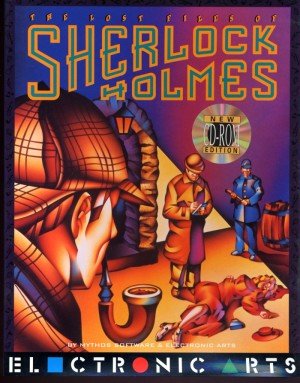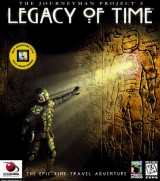Review for The Marionette

Each day you wake up, put the coffee on, eat breakfast, and head out the door to school or work. You come home, take out the trash, sit down to dinner, go to bed, and the cycle starts all over again. Or maybe today you meet the love of your life but don’t realize it, and you set off a cycle of dire events by giving her the brush off. At any given moment, who or what set you on the path that you now travel every day? Was it your parents? Your upbringing? Some innate “youness”? Who is pulling your strings as you live out your life? The Marionette, a freeware adventure by Team Effigy, is a moody exploration of a young man’s attempt to answer these questions.
I found The Marionette to be an atmospheric joy to wander around in for a few hours on a rainy evening, apart from some intentionally sharp jolts. All of the various elements of the game – the story, the art, the music, the gameplay, and the dialogue – contributed to the dark, dreamlike quality, which I enjoyed a lot. In this first-person point-and-click adventure, you play as a sculptor named Martin. Players are thrown into the middle of Martin’s abruptly disordered life as he wakes up in his car parked in front of a dilapidated house, having no idea how he arrived there or whose house it is. Upon entering, you’ll find it appears to belong to a young girl named Alice, and a cryptic guide named Giuseppe indicates that the mysterious Alice has an agenda to lead Martin through the rest of the house, leaving clues to help him escape each room and ultimately get back to his own life.
As Martin begins exploring, he figuratively walks through the looking glass, stepping through a door and into a scene not from Alice’s past, but his own. It’s at this point that Martin realizes this house is no ordinary house. Each “room” that he explores – a sterile art gallery with surreal art pieces, a two-bit apartment in San Francisco spruced up to look more expensive than it is, a drab grey room with walls covered by insane scrawls – is a test that offers insight not only into Martin’s life, but Alice’s as well. The main challenge of each room is simply figuring out how to leave, as none of them appear to have logical exits when you first enter. As you progress through the story, it becomes clear that each room contains memories that may belong to Martin, Alice, or someone else altogether, and the further you get, the more surreal the atmosphere becomes. In fact, Martin’s quest begins to seem more like a spiritual or philosophical journey than a real one.
Contributing to this rich atmosphere, the artwork in The Marionnette starts off with a warm, burnt sienna style that leaves you feeling as if you’re exploring a charcoal sketch. The house is brown and faded, but there are touches of color as you progress: an azure sky outside, the splash of white water lilies above green pads, and pastel blues and lavenders in the gallery. Everything is soft, with muted edges, adding to the dreamy feel of Martin’s journey. The cutscenes reminded me of comic book panels, the camera panning across sketches of Martin or Alice during pivotal moments in the story. The game designers added some other nice touches also – the sculpture of a homeless man huddled in a corner, a black dressmaker’s mannequin that reinforces the marionette theme, and the to-do list of a stage mother pushing her daughter into the world of modeling – that reveals more about the characters without too much exposition.
The music is also suitably atmospheric and moody, and at times I imagined a ballerina in a music box, spinning around to tinkling music. It can become repetitive in certain rooms, however, especially if you’re stuck trying to figure out how to get out of your current situation. There are few noticeable ambient sounds – no jingling keys or creaky floor boards – which would have added some welcome depth to the aural experience.
The interface is easy to use, with the right mouse button cycling through only a few actions – look, interact, and speak – and left-clicks used on the desired objects. Hotspots are not highlighted in any way, but they aren’t difficult to find and you can interact with many things in each room: the floors, the artwork, curtains, toys, etc. A foot cursor appears where you can move within each room, as well as showing you the exit when you discover a way to leave the room entirely. Such simplicity is always a plus in my book, as you can immerse yourself in the story without struggling to figure out how to pick up a note or interact with a painting. The inventory system is also logical, as you’re not carrying large items around like ladders and brooms. When you do use an item, it disappears, keeping the clutter to a minimum.
Puzzles in The Marionette are mostly environmental, so you might find yourself picking up scraps of paper that need to be rearranged later or examining objects for clues on how to open locks. For the most part, these tasks make sense within the context of the story, and each provides a new glimpse into Martin’s identity or Alice’s motivations. When you play a round of hangman, a word-guessing game, you gain not only another clue about how to move on, but also a peek into the warped, childlike mind of the puzzle’s puppeteer. There are a few timed puzzles at the end, such as trapping a murderous mannequin or quickly ascertaining which inventory item you’ll need, but these aren’t too difficult. I’m probably the worst walkthrough wimp there is, but I found the puzzles to be so logically integrated that I was always able to figure out the solution.
The writing is well done and often witty (“I already know this isn’t my key, but what have I got to lose… Two seconds apparently, oh well.”). There is no spoken dialogue in The Marionette, however, so you’ll be doing a lot of reading in the game, whether it is conversation between characters, magazine spreads, letters, or journal entries. The lives of Martin and Alice are both revealed in their journals, but may or may not tell us who they really are. Certain references to Pinocchio and his creator bring to mind images of puppets and puppet masters, but also of liars. Is Martin a reliable narrator, truly the victim that he seems? And what of Giuseppe? Ostensibly he is there to help Martin, and at times seems genuinely afraid of what Alice will do if Martin angers her. But we don’t learn how he knows Alice, how he came to be in the house, or why he is acting as a guide. Is he part of Alice’s game or Martin’s deluded imagination?
What you discover continually brings you back to the question: Who is pulling the strings here? That question even extends to you, the player. The multiple endings (there are different results depending on certain choices you make at the end of the game) set up a scenario in which you determine which way the puppets will play out their final scenes. But which choices are really yours, and which did you pick because the game’s designers were pulling your strings?
The successful mix of artwork and music in creating a dreamlike atmosphere, plus the integration of logical puzzles that propel the story forward rather than stopping the action, all contribute to making The Marionette an enjoyable game, and one that’s free of charge for good measure. The experience proved to be more than just manipulating a character through a set of obstacles; it got me to think about how we interact with stories and with games. Those put off by surreal stories that don’t tie up every loose end may be disappointed to finish with more questions than answers. But even as my own questions grew, I wanted to finish the game, I wanted to get Martin back to his own life, and, more importantly, I wanted to find out who Alice was and what she meant to Martin. So for those of you ready to break out of your daily rut and drop off into a dreamlike adventure for a few hours, you can’t go wrong with The Marionette.
The Marionette can be downloaded from the AGS website.








